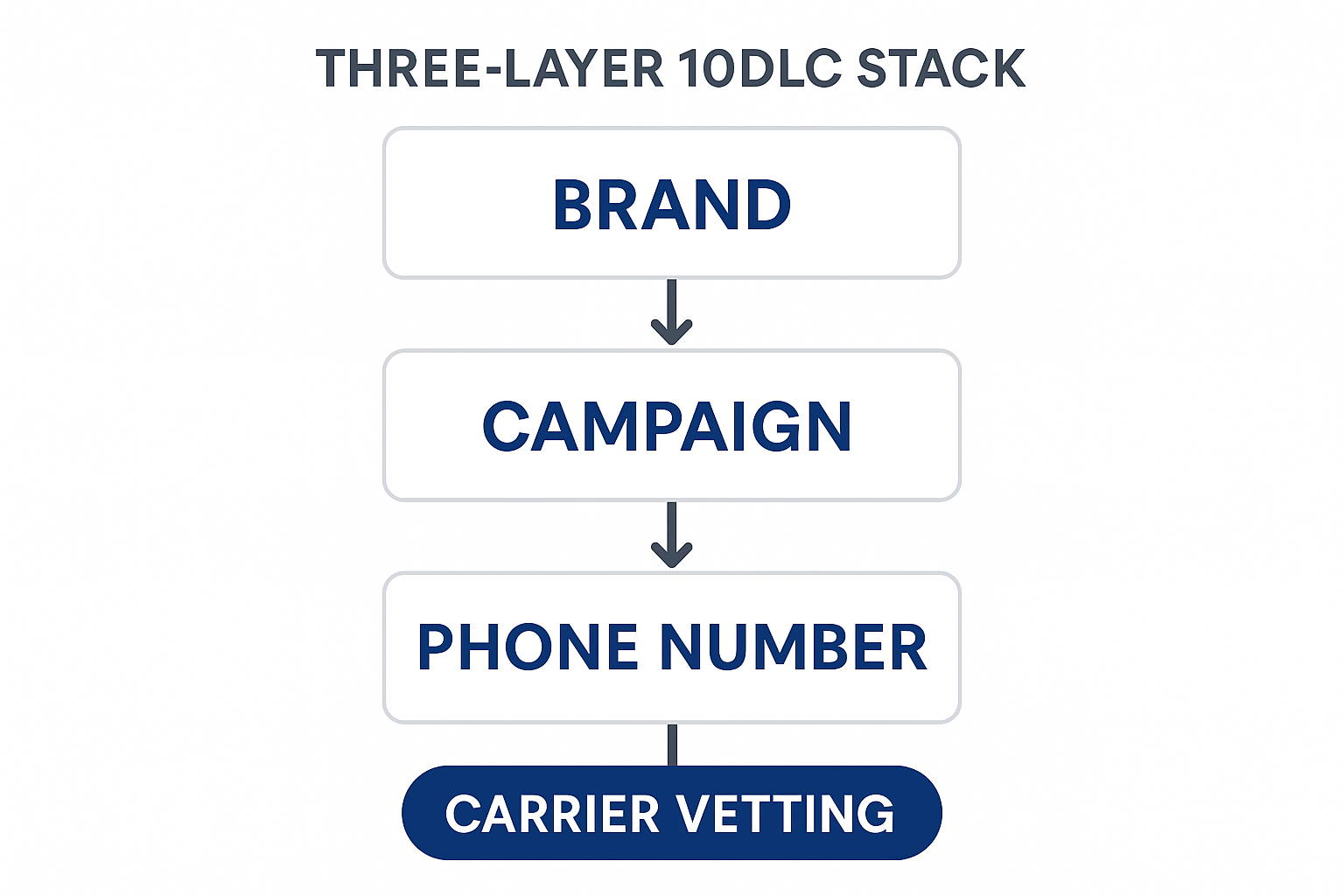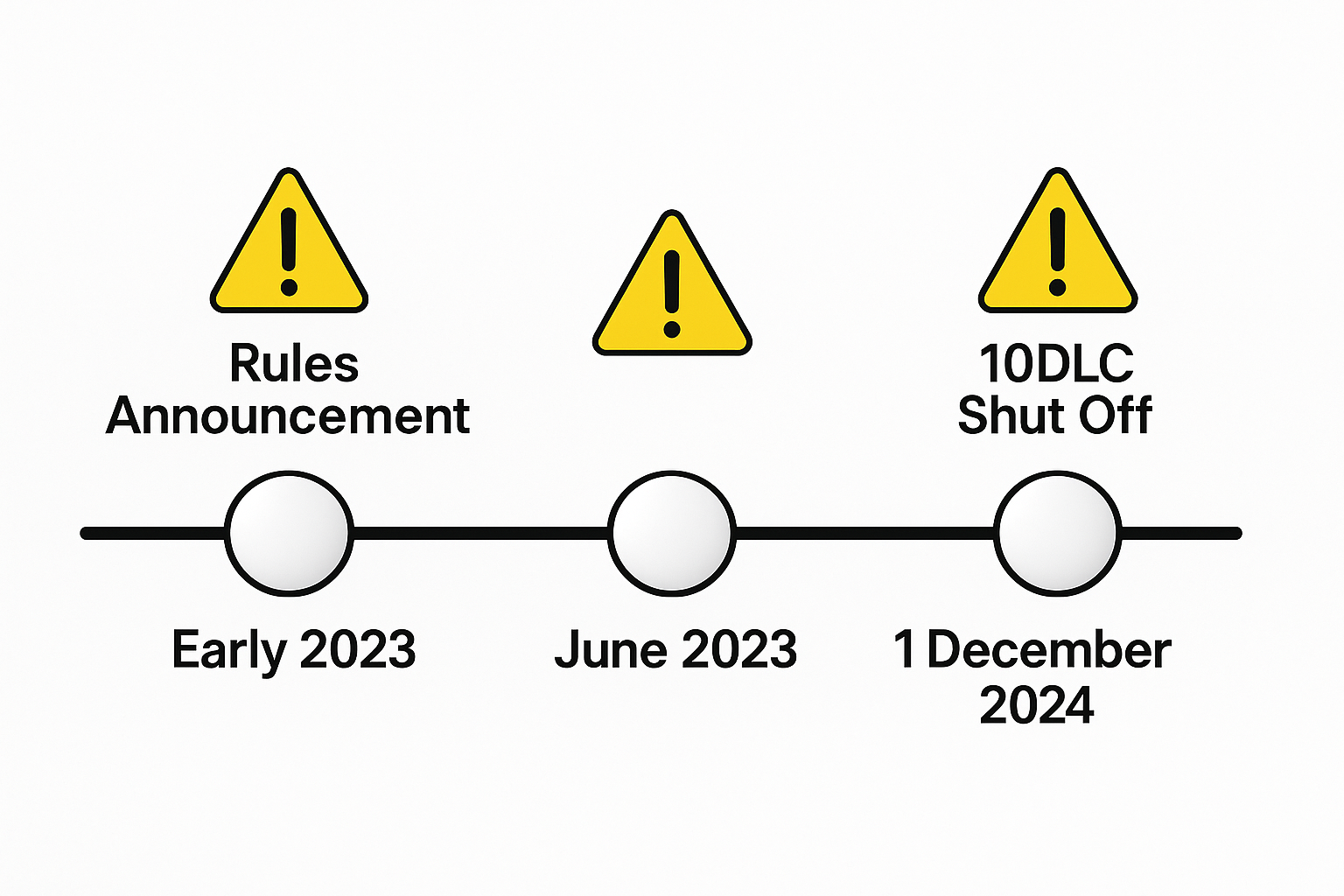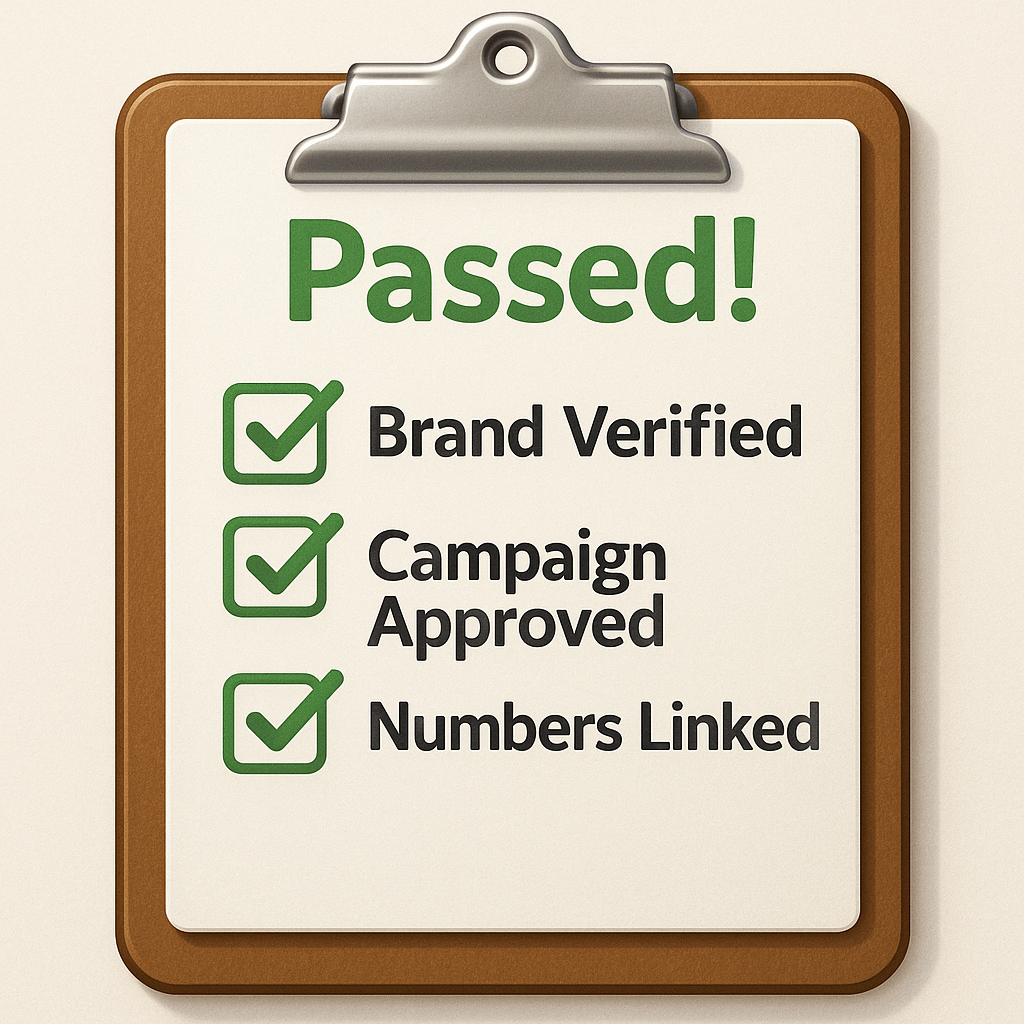Every U.S. business that texts customers from a local phone number must complete 10DLC compliance brand registration, campaign vetting, and phone number linking before carriers shut off unregistered traffic on 1 December 2024. Get an EIN, submit three sample messages with opt in wording, pay small registry fees, and assign each compliant number to an approved 10DLC campaign; your messages will then pass carrier filters and reach customers.
Why carriers invented 10DLC and why the FCC backs it
Long code texting exploded, spam soared, and customers complained, so mobile carriers demanded verified senders and message transparency. The FCC’s first scam texting rules require providers to block suspicious numbers and maintain a “Do Not Originate” list, creating regulatory muscle behind carrier policies.
Carriers joined CTIA to frame the Messaging Principles and Best Practices, which spell out consent, opt in, and opt out standards for every 10 digit text. The guidelines emphasize consumer trust, truthful calls to action, and clear HELP / STOP instructions for any A2P 10DLC compliance program.
Key terms everyone mixes up
Brand means your legal business identity, verified with an EIN or D-U-N-S number. Campaign is a description of how you will use SMS, such as marketing, customer care, or onetime passwords. Phone number is the actual 10 digit long code that must live inside one approved campaign. This neat three layer stack drives higher throughput, lower filtering, and better customer confidence.
The decisive 10DLC registration deadline
Mobile carriers will block or heavily throttle unregistered traffic starting 1 December 2024, removing grace periods that previously allowed “best effort” delivery. Brands that ignore the 10DLC registration deadline risk dropped messages, higher per segment fees, and permanent suspension of their messaging accounts.
Step by step 10DLC compliance checklist
1. Collect business documents legal name, address, EIN, website, and contact email.
2. Create your brand record inside a carrier portal or Campaign Registry dashboard; approval usually takes minutes, but mismatched details cause delays.
3. Pick your campaign type and write three sample messages that show opt in, content, and opt out wording; avoid URL shorteners that obscure the destination.
4. Add consent language to every acquisition channel, including web forms, POS pads, and voice calls, because carriers expect clear proof of permission.
5. Link each phone number to the approved campaign and confirm via a test message that carrier vetting has cleared; this step activates throughput tiers.
6. Monitor delivery reports and keep trust scores high by honoring STOP requests immediately and updating campaigns when content changes.
10DLC compliance FCC guidelines
The FCC treats unwanted texts like illegal robocalls, so providers must block obvious spoofing, label high risk traffic, and give consumers easier opt out pathways. Businesses that stay within approved campaigns and respect opt out keywords stay clear of potential fines.
A2P 10DLC compliance versus person to person texting
Application to Person (A2P) messages are automated, scaled, and monetized, while P2P chats are low volume and conversational. Carriers evaluate A2P traffic under strict 10DLC campaign policies, granting better speed only when brands register and follow the rules.
10 dlc compliance phone number best practices
Register every new phone number before its first outbound text, because carriers match originating addresses to approved campaigns in real time. Recycled or freshly purchased numbers often inherit negative reputations, so cleansing and early registration avoid deliverability issues.
10 dlc compliance Zoom success story
Zoom required every customer using Zoom Phone SMS to place their numbers inside an approved 10DLC campaign by February 2025. Admins submit brand information through the Zoom portal, receive quick approval, and avoid disrupted meeting reminders thanks to the compliance upgrade.
10dlc campaign examples you can copy
| Use case | Sample message | Opt in source |
|---|---|---|
| Appointment Reminders | “Hi Sam, your dental cleaning is tomorrow at 10 a.m. Reply YES to confirm.” | Checkbox on booking form |
| Two factor Authentication | “Your SecureBank code is 238891. Reply HELP for support, STOP to quit.” | Login page option |
| Flash Sale | “BargainMart flash sale ends tonight. Show code FLASH25 in store. STOP to unsubscribe.” | SMS keyword “SALE” |
These structured samples satisfy carrier vetting teams because they show brand, purpose, and opt out instructions clearly.
10dlc opt in example that passes every review
“By clicking ‘Subscribe’, I agree to receive recurring informational and promotional SMS from ACME Tools at my mobile number. Message frequency varies. I can reply STOP to cancel or HELP for help. Message and data rates may apply.”
This wording hits every carrier requirement brand name, consent, frequency, opt out, and fees and stands as a textbook 10dlc opt in example for future audits.

Fees and throughput: what to expect after approval
Brand registration costs four dollars, campaign vetting runs fifteen dollars, and carrier pass through fees apply per message segment, but compliant senders unlock up to sixty messages per second on high trust campaigns. Higher trust scores also reduce spam filtering, so registration pays for itself through reliable delivery.
Penalties for ignoring compliance
Unregistered traffic faces immediate blocking, out of band filtering, surcharges that can triple message costs, and potential FCC enforcement for deceptive communications. Some carriers permanently blacklist numbers that violate repeated warnings, forcing costly number migrations and campaign rebuilds.

Maintaining healthy 10dlc sms campaign performance
After approval, treat delivery reports like live telemetry and watch for sudden dips that indicate carrier scrutiny. Rotate content, remove URLs that repeatedly trigger spam filters, and re verify opt in records quarterly to show good faith compliance if questioned.
High volume senders should stagger peaks to stay under per second caps, because carriers throttle without warning when traffic surges beyond agreed limits. Using separate campaigns for marketing and transactional alerts also preserves trust scores by isolating different message types.
Common reasons campaigns get denied and fast fixes
- Mismatched business names: ensure brand name equals IRS name, not DBA only.
- Vague sample messages: rewrite with full sentences showing keywords, URLs, and opt out wording.
- Missing privacy policy link: provide a working HTTPS link; carriers click and verify.
- SHAFT content: remove any references to sex, hate, alcohol, firearms, or tobacco unless age gated.
Quickly correcting these issues and resubmitting usually clears review within forty eight hours.

FAQs
1. Is 10DLC mandatory for every U.S. brand?
Yes, any organization sending automated texts from local numbers must comply, regardless of size or industry.
2. How long does approval usually take?
Brand approval is instant when details match government records, but campaign vetting can take up to three business days.
3. What does 10DLC compliance phone number registration cost?
Expect a four dollar brand fee, fifteen dollar campaign vet, and small per segment carrier surcharges.
4. Does the FCC fine non compliant senders?
The FCC focuses on carriers blocking traffic, yet deceptive or spoofed messaging can trigger multi million dollar fines under the TCPA.
5. Can I register one number under multiple campaigns?
Carriers require every number to attach to exactly one active campaign at any given time, so use additional numbers for separate purposes.
SuperU automates 10DLC registration and powers AI voice SMS conversations so your business texts customers with total confidence.
Start for Free – Create Your First Voice Agent in Minutes


